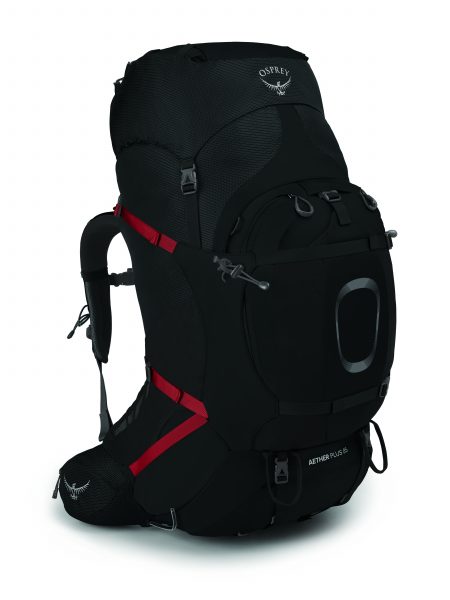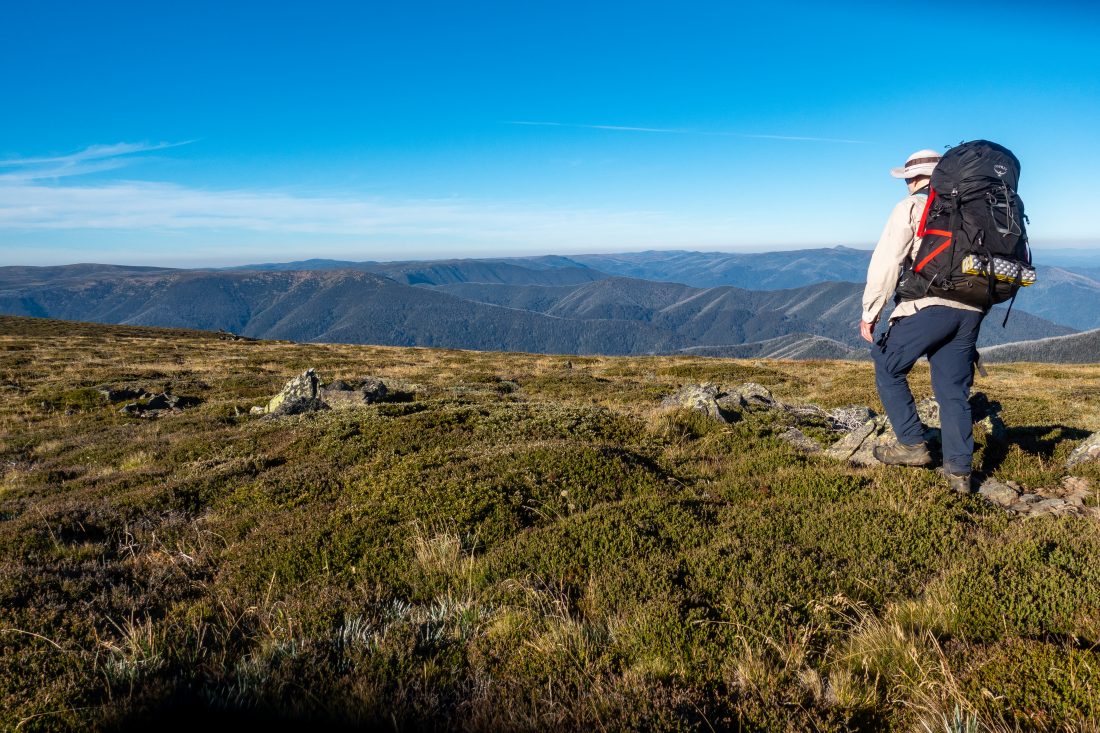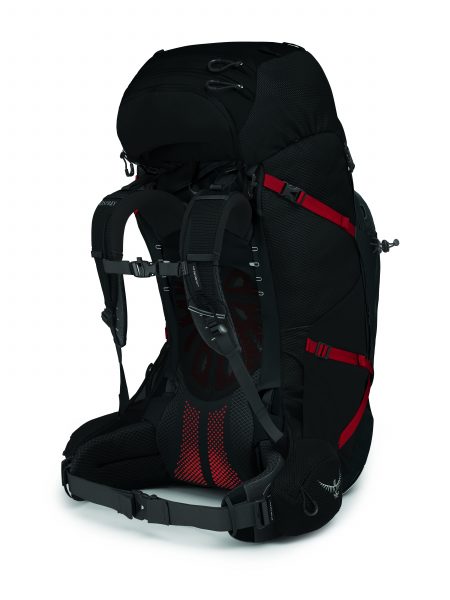
GEAR REVIEW
OSPREY:
Aether Plus 85
Craig Pearce puts the next generation Aether Plus to the test in the Victorian Alps,
and finds it to be a serious contender.
(This story originally featured in Wild #180)
I wanted to try out my son’s Osprey Aether Pro 70L pack for a multidayer at Mutawintji. I called it ‘borrowing’. My son called it ‘theft’. My wife arched an eyebrow. I mean, hello, it was me who’d paid for the thing! Anyway, I pulled off the heist, and was so impressed by the comfort of its harness system that when a new generation of Osprey packs was released, I was eager to give one a crack.
The upshot? I was impressed. I ended up going with the Aether Plus 85, although because I went for the S/M version, it was actually 83L (the L/XL is the full 85). Advertised at 2.76kg (my scales said 2.95), the Aether Plus 85 was heavier than the pack I’d been using, but without a doubt the harness system—upgraded from the generation of packs my son was using—made this ride the most comfortable backpack I’ve ever experienced. #designcounts.
And for me, as someone who likes his multidayers, comfort is the crux. There’s a lot of science that goes into these packs, and plenty of excellent options, but Osprey is clearly a leader in the field. It probably helps that they’re primarily a pack-only company. That is what they’re dedicated to producing, so they have sound commercial motivation for getting it right.
After trying an interchangeable approach to hip-belts and harnesses in its previous generation of packs, with the Aethers it was back to the single setup, this time with a focus on making sure the harnessing, shoulder straps and hip belt can easily be adjusted to the individual—and while in action. I found this ‘fit-on-the-fly’ capability—on a 70km, four-day walk up-ing and down-ing in the Victorian Alps carrying 18-20kg—to work efficiently.
One reason for the Ospreys’ comfort factor is that they’re comparatively slim and tall. The load is held snug to the back; there’s minimal pulling away from the shoulders. This reverse ‘pull’ has been the primary pain point for me when using backpacks. The Aether does a noticeably good job of getting the weight to sit on the hips, rather than the delicate shoulder musculature. The stability was excellent

The upshot? I was impressed. I ended up going with the Aether Plus 85, although because I went for the S/M version, it was actually 83L (the L/XL is the full 85). Advertised at 2.76kg (my scales said 2.95), the Aether Plus 85 was heavier than the pack I’d been using, but without a doubt the harness system—upgraded from the generation of packs my son was using—made this ride the most comfortable backpack I’ve ever experienced. #designcounts.
And for me, as someone who likes his multidayers, comfort is the crux. There’s a lot of science that goes into these packs, and plenty of excellent options, but Osprey is clearly a leader in the field. It probably helps that they’re primarily a pack-only company. That is what they’re dedicated to producing, so they have sound commercial motivation for getting it right.
After trying an interchangeable approach to hip-belts and harnesses in its previous generation of packs, with the Aethers it was back to the single setup, this time with a focus on making sure the harnessing, shoulder straps and hip belt can easily be adjusted to the individual—and while in action. I found this ‘fit-on-the-fly’ capability—on a 70km, four-day walk up-ing and down-ing in the Victorian Alps carrying 18-20kg—to work efficiently.
One reason for the Ospreys’ comfort factor is that they’re comparatively slim and tall. The load is held snug to the back; there’s minimal pulling away from the shoulders. This reverse ‘pull’ has been the primary pain point for me when using backpacks. The Aether does a noticeably good job of getting the weight to sit on the hips, rather than the delicate shoulder musculature. The stability was excellent.
The other big Aether bonuses, for me, are the detachable daypack, and the many externally accessible pockets. Both features—especially when you’re doing multi-dayers, which you will be; you’re not going to lug around an 85L pack otherwise—are extremely practical. Yet not all packs have them and/or do a good job with them. The daypack setup is simple once you get the gist. For me this was a weight saver, as I would have taken something to do the job anyway. The volume is ideal for your random diversion 101 gear: jacket, water, food, camera, safety and nav stuff etc.
And the pockets? Perfect for my needs. Four large ones (three frontal, one in the lid), two small ones (both on the lid, with the day pack feature being workable as a small pocket, too) and two generous hip-belt pockets. The latter are useful for glasses, small cameras, snacks, maps etc.
Other features include a raincover (its roomy pocket provides yet another option to stow gear), floating top lid, an integrated FlapJacket for lidless use, dual ice axe loops, side and front panel compression straps, attachments for trekking poles, and other straps that allow for random bits to be lashed to the pack. There is also front-panel access to the main compartment.

The Aether Plus range has 60 to 100 litre options. The women’s equivalent—Ariel Plus—runs from 60 to 85 litres. The ranges have impressive sustainability characteristics. They include most (if not all) harmful substances being removed from their production; the fabric does not have toxic chemicals in its water-repelling constituents (ie its DWR finish is PFC-free; see this issue’s story ‘The DWR Conundrum’ starting on p42); the suspension system almost eliminates plastic waste in its manufacturing (thanks to the frame being injection moulded); and the company actively works to reduce and offset its carbon footprint.
Niggles? Well, I still haven’t found a pack where my non-contortionist self (okay, so I’m not in my supple 20s) can easily access a water bottle from the side-pockets designed for this purpose. I’d hope the Aether Plus might be the first; sadly, it wasn’t to be. There is also a slight weight penalty paid through the generous number of pockets, the daypack attachment, and the sleeping bag partition within the pack itself. While the former two features are more than worth the weight gain, the latter feature is pointless in my view, and can’t be removed despite the website claiming otherwise; you can ‘decommission’ the divider, but unless you cut it out, it’s attached to the pack. Other than that—and ditching the unnecessary but now seemingly de rigueur bladder system—the comfort, volume and features make the Aether Plus 85 a serious contender. Retailing at $540, it offers sound value for money. I plan on happily using mine for many treks to come.
Craig Pearce
NEED TO KNOW
Volume: S/M 83L; L/XL 85L
Intended load range: 18-32kg
Weight (S/M as tested): 2,950g
Detachable daypack: Yes
RRP: $539.95
More info: osprey.com

